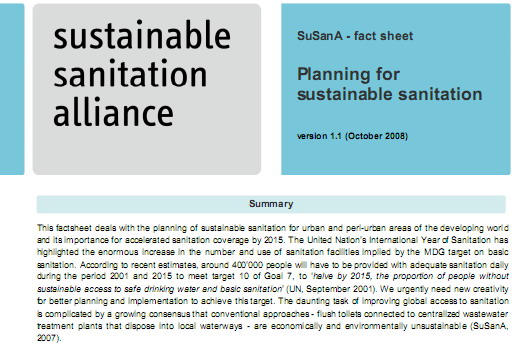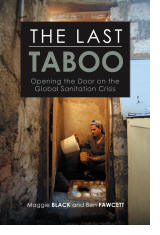The call for better planning and long-term sustainability in sanitation projects is understandable considering still 2.5 billion people unserved with improved sanitation (and probably the same amount with non-sustainable sanitation). The UN International Year of Sanitation 2008 is chosen by several initiatives as the most appropriate time for publishing new guidelines and planning tools for sanitation.
 The new fact sheet of the SuSanA working group “Sustainable Sanitation for cities and planning” summarizes the 3 most important planning documents: Sanitation 21 (IWA), HCES – Household Centred Environmental Sanitation (WSSCC/Eawag-Sandec) and SSA – Strategic Sanitation Approach (WSP). The fact sheet can be downloaded here: http://www.susana.org/images/documents/05-working-groups/wg06/final-docs/en-susana-factsheet-WG06-planning-version-1.1.pdf.
The new fact sheet of the SuSanA working group “Sustainable Sanitation for cities and planning” summarizes the 3 most important planning documents: Sanitation 21 (IWA), HCES – Household Centred Environmental Sanitation (WSSCC/Eawag-Sandec) and SSA – Strategic Sanitation Approach (WSP). The fact sheet can be downloaded here: http://www.susana.org/images/documents/05-working-groups/wg06/final-docs/en-susana-factsheet-WG06-planning-version-1.1.pdf.
The Austrian Development Agency (ADA) in cooperation with the EcoSan Club has published a brochure on planning principles “Solutions in Sanitation – Planning Principles”. The publication is available as download: http://www.entwicklung.at/en/service/publikationen/folder-und-broschueren.html. That link offers also the possibility to order hard copies.
Furthermore NETSSAF also published a participatory planning tool which was distributed at the final conference of the network “Pathways towards Sustainable Sanitation in Africa” in September 2008 in Ouagadougou, Burkina Faso. It will be available soon at the webpage of the network.

 TOPIC: The ‘Great Stink’ of the 21st Century
TOPIC: The ‘Great Stink’ of the 21st Century